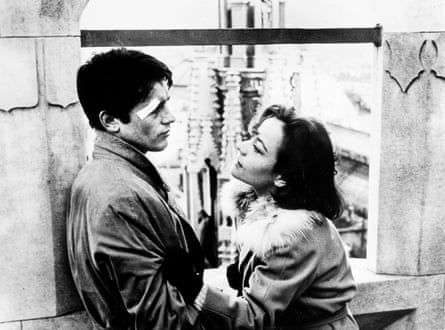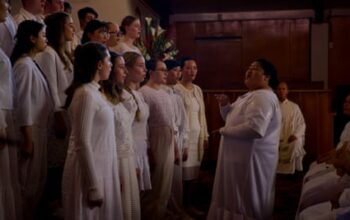There is a famous photograph of Alain Delon in 1967, sitting on a couch next to Marianne Faithfull, with a subdued Mick Jagger on the other side of her, apparently taken around the time Faithfull was about to star in The Girl on a Motorcycle, in which Faithfull modelled a sleek leather body suit that Delon’s character would take great delight in unzipping. Faithfull is leaning over intimately as Delon murmurs to her, laughing, lit up in his presence, her body language entirely enfolded into his. Jagger can only look down uneasily at his cigarette. Later Faithfull would say that she didn’t fancy Delon one bit, but confirmed that Jagger was very jealous.
Be that as it may, it is hard to think of anyone who, if only for a split second, could have upstaged Jagger at that moment, who could have drawn the gaze of Faithfull and the press cameras to him. And that is Delon, in all his eerie, heartstopping, almost extraterrestrial gorgeousness. He was one of the most – maybe the most – beautiful male stars in cinema history.

Delon had a mesmerically demure, long-lashed, almost feline look that could indicate something mysterious, or wounded, or malign, and was very different from the more candid Hollywood beauty of Paul Newman or Robert Redford – and Delon never made it in Hollywood. He had an unlocatable charisma to go with his beauty, the dangerous apparent passivity and stillness of a predator, and it was this that got him cast in some of the most fascinating crime pictures of the era (by French directors René Clément, Jacques Deray and Jean-Pierre Melville) as well as the bold new Italian art cinema of Visconti and Antonioni. He was a tough guy and no dandy, but it was his exquisite face that made him such an exotic figure in working-class stories or lowlife dramas.
And it was this that showed us the imprisoning effect of great beauty, a commonplace for female stars but rare for men. Tellingly, his first film credit was in a 1958 crime caper, opposite fellow newcomer Jean-Paul Belmondo, called Sois Belle et Tais-Toi (Be Beautiful and Shut Up) – an order normally addressed to a woman in that sexist age. Delon’s beauty imposed a stillness on him, a growing sense that the radiation of his glamour would be strongest when he was coolly immobile and let that amazing face simply have its effect on the camera.

In his breakthrough movie, Delon played Rocco in Visconti’s Rocco and His Brothers in 1960. He is the brother who comes to Milan to be with his extended family of siblings and start a new aspirational life in that assumed centre of prosperity, but ends up tragically sacrificing his own wellbeing for his brothers – especially in pursuing a career in the boxing ring, where, as the audience would surely know, that beautiful face would soon get damaged. In Visconti’s The Leopard (1963), based on the Lampedusa novel, Delon was the handsome and patrician Tancredi, heir to Burt Lancaster’s troubled and complex Prince of Salina.
A more quintessential Delon role came in the same year as Rocco: Tom Ripley in Plein Soleil, or Purple Noon, Clément’s adaptation of Patricia Highsmith’s The Talented Mr Ripley, the story of a sociopath and killer with a weird knack of imitating people. I’ve always thought that Delon’s unearthly perfection is creepy itself, as if he is imitating a human being. This is a man, you think, who has grown used to a dazed, rapt expression on the faces of people talking to him, accustomed to their submissive awe, and yet with a diabolical insight into how that magnetism can be harnessed to manipulate and coerce. Delon’s Ripley is a Dorian Gray portrait of male beauty and unscrupulous daring, untroubled by conscience. He was comparably cool and self-controlled in Deray’s psychological thriller La Piscine, or The Swimming Pool, in which the Delon face could itself be a pool: merely a rippling calm or churned up with violence.
He was similarly enigmatic and difficult in Antonioni’s L’Eclisse (The Eclipse) in 1962, as the nervy and conceited young stockbroker who embarks on an affair with Monica Vitti (one of the few female co-stars who could match Delon’s beauty and sphinx-life refusal to disclose an inner emotional life). Louis Malle tapped into Delon’s capacity for otherworld strangeness by casting him in the “William Wilson” doppelganger story of his portmanteau movie Spirits of the Dead in 1968.

But it was in the crime pictures of Melville that Delon’s image became more iconic: clarified, or possibly paralysed by his own sense of his image. He starred in Le Samouraï (1967), The Red Circle (1970) and the underrated Un Flic (1972). In the first two of these, he is the villain, in the third the police officer, but always with that impassive, enigmatically enclosed self-possession. In Le Samouraï he is the cool, unsmiling hitman with the Anglicised name of Jef (just the one “f”) Costello in a Bogartian trenchcoat, but the comparison ends there. This killer has a monkish vocation for killing and there is something ascetic in Costello that corresponds to Delon’s willingness simply to impress his personality on the camera, like a silent film actor. He is reticent in the other two movies as well, especially as the hardbitten cop who only really comes to life when responding to a call on his squad-car radio.
My vote, though, for Delon’s greatest role, and greatest Delon achievement, is one that grew out of the enigmatic crime roles into which he had evolved in the late 1960s and 70s: Joseph Losey’s Kafka-esque doppelganger mystery Monsieur Klein from 1976. (It was entered into competition at Cannes, losing out to Scorsese’s Taxi Driver.)
Delon produced the movie and played Klein, a wealthy art dealer in occupied Paris with a handsome apartment, a beautiful mistress and elegant circle of friends. He has no great problems with the Nazis, especially as they are boosting his business. Terrified Jewish people are coming to him, offering paintings for sale to fund their escape from France, and Klein exploits their desperation to get bargains. But then he starts getting a Jewish newsletter delivered to his door: evidently there is someone else in Paris with his name, a Jew, and a terrible mistake has been made … hasn’t it? Or is it someone trying to discredit him? Klein goes to the police to point this out, but then worries they will think he actually is a Jew, and that this is a double bluff. His problems with officialdom escalate: he is unable to complain forcefully because of a fear that will merely make him look guilty. Eventually, he is taken away in the roundup – one of the most disturbing and plausible screen portrayals of that shameful French historical episode.
Like the hitman in Le Samouraï , Klein is self-contained and withdrawn. Almost a decade on from the Melville crime classic, Delon’s impassivity has achieved something refined and mandarin-like, but morally compromised. There is a genius to his performance when he effectively humiliates a Jewish customer by getting a cut-price picture and on the way out, this man points out the newsletter on his mat – like the ones he himself gets. Delon’s face flickers with fear, astonishment, distaste, panic and a clear sense that to betray any emotion would be a defeat. In a way, this is his masterpiece.
Delon’s career was prolific and he had many roles: perhaps one should also point out his mature role as the ageing, cantankerous epicure Baron de Charlus in Volker Schlöndorff’s Swann in Love in 1984; ingenious casting, although Delon was not entirely relaxed in the part. In latter years, Alain Delon was to become notorious for his gruesome admiration for the far-right politics of the Front National and (like Sean Connery) for some odious remarks about slapping women. But he redeemed himself, politically, for his support for Losey and the study of antisemitism that was Monsieur Klein. He was an icon, and a symbol of the lost beauty of the 1960s.
Source: theguardian.com


